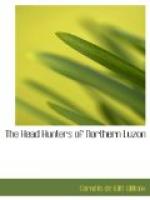Evidently the possibility of obtaining an answer to this question depends on the possibility of determining, within allowable limits of precision, the qualities and defects of the Filipino peoples. Now, this is a difficult thing to do, but it is not an impossible thing; at any rate, a first approximation may be derived from the authorities quoted in the “Census of the Philippine Islands,” 1903, pp 492 et seq. In time, these authorities range from Legaspi, 1565, to our own day, and include governors, prelates, travellers, engineers, priests, etc., among whom are found Spaniards, Englishmen, Americans, and Filipinos, As might be expected, all sorts of qualities and defects are reported. Classifying these, and rejecting from consideration all, whether quality or defect, not supported by at least five authorities, it may be concluded, so far as this induction goes, that the Filipino is, on the one hand, hospitable, courageous, fond of music, show, and display; and, on the other, indolent, superstitious, dishonest, and addicted to gambling. One quality, imitativeness, is possibly neutral. It would appear that his virtues do not especially look toward thrift—i.e., economic independence—and that his defects positively look the other way. If the witnesses testifying be challenged on the score of incompetency, let us turn to the reports of the supervisors of the census, contained in the volume already cited; for these cover the entire Archipelago, and set forth actual conditions at one and the same epoch, 1903, the date of the census. Moreover, these supervisors, as welt as the special agents and enumerators, were nearly all natives. When, therefore, these supervisors report the mass of the Christianized Filipinos as simple and superstitious, we may be sure that we have the truth; but we are also inevitably led to the conclusion of economic unfitness. As this matter of economic independence is one of the first importance in determining the future of the Islands, we must look for all the light possible on the question. A flood is thrown on it by an article entitled “Nulla est Redemptio,” published in the (native) La Democracia, of Manila, October 10, 1910, and believed to be the production of perhaps the ablest Filipino alive to-day. Premising that agriculture is the chief source of Philippine wealth, and that this source failing, all others must fail, the author points out that, although taxes are lighter in the Archipelago than in any other country, production is much less, and that this is the chief cause of the prevailing economic distress. He points out further that the Assembly is wholly native, as are all municipal and nearly all provincial officers, and that therefore they, and the constituencies that elected them, must assume responsibility. Now, what has been achieved? The provinces have spent money on buildings and parks, but, with one brilliant exception, none on roads. Nothing has been done




